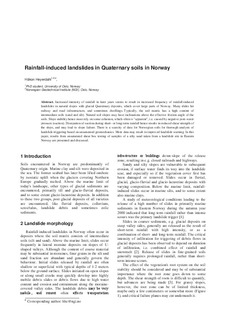| dc.description.abstract | Increased intensity of rainfall in later years seems to result in increased frequency of rainfall-induced landslides in natural slopes with glacial Quaternary deposits, which cover large parts of Norway. Many slides hit railway and road infrastructure, and sometimes dwellings. Typically, the soil matrix has a high content of intermediate soils (sand and silt). Natural soil slopes may have inclinations above the effective friction angle of the soils. Slope stability hence must rely on some cohesion, which often is “apparent”, i.e. caused by negative pore-water pressure (suction). Dissipation of suction during short- or long-term rainfall hence results in reduced shear strength of the slope, and may lead to slope failure. There is a scarcity of data for Norwegian soils for thorough analysis of landslide triggering based on unsaturated geomechanics. More data may result in improved landslide warning. In this paper, results from unsaturated shear box testing of samples of a silty sand taken from a landslide site in Eastern Norway are presented and discussed. | |
